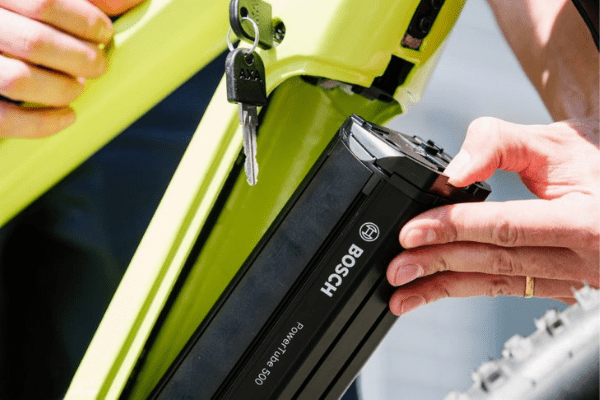Last week we took you to discover the MOTOR.
We have explained the different characteristics and why it is important to understand "what you want to do with an e-bike", before deciding which motor to rely on.
There is another fundamental element that influences the purchase of an e-bike: battery.
The latest generation batteries are all lithium ion and differ from each other, essentially due to the positioning and, above all, the energy capacity.
The positioning of the battery essentially affects the overall aesthetic appearance of the bicycle and has almost no impact on the essential and performance aspects: it is in fact possible that the battery is positioned externally to the frame or integrated within the frame itself.
In the first case we will have a removable battery in a simpler way but a slightly aesthetic impact’ coarser and certainly less harmonious.
In the case of an integrated battery, this is integrated inside the frame and determines a very pleasant visual impact that almost leads to confusing an electric bike with a muscular one.
The essential element that differentiates one e-bike from another is, however, the energy capacity, which can vary from a minimum of 250 Wh (they practically no longer exist) to a maximum of 900 Wh.
The capacity of a battery is the element that tells us how much autonomy it can provide us, that is, how many kilometers we can travel and what differences in altitude we can overcome.
In reality, the capacity of the battery cannot be analyzed alone but must be closely related to the amount of energy absorbed by the engine to provide the propulsive force.
In fact, it is the mix of these two components that determines the autonomy of a battery and it is not impossible to find 900 Wh batteries which actually guarantee less autonomy than a 625 Wh battery; this is precisely due to excessive energy absorption by the engine.
The best relationship between motor and battery can be found on Bosch, Brose, Shimano, Yamaha and Oli motors which have now reached an almost perfect level of integration.
Generally, the batteries mounted on bicycles for the city (City e-bike) range from 250 to 500 Wh and guarantee autonomy ranging from 30 to 70 kilometres, imagining flat terrain or with modest climbs.
The batteries mounted on e-bikes for trekking or sporting activities (Mountain e-bikes) have a capacity varying between 500 and 720 Wh and allow you to travel distances varying between 70 and 100 kilometers which can be reduced in case of routes with very long and steep climbs.
Of course, a battery's range is affected by several other factors such as the rider's weight, the level of assistance being used, the terrain, the frequency and length of climbs, the type of bike, the rider's posture and more. .
However, to increase the autonomy of your e-bike you can adopt some easy measures, such as:
- Use the maximum assistance level as little as possible;
- Use an agile ratio at the start of the gear and then change it during acceleration;
- Check tire pressure regularly;
- Check your posture;
Normally a battery has an estimated lifespan of around 5-6 years and in any case approximately requires 800-1000 complete charging cycles, considering that a complete charging cycle involves recharging the battery from 0 to 100%.
Here are some tips to keep your battery running longer:
- Keep the battery in dry places and at a temperature between 0 and 20 degrees;
- Don't park your e-bike in sunny places or leave it outside when temperatures drop below freezing;
- Always use the manufacturer's charger;
- Recharge the battery after each ride and do not let it discharge completely;
- Charge the battery at least once every three months;
- If used in winter, store the battery at home and hook it up just before leaving;
- Do not immerse in water or clean with pressure washers or strong water jets;
- Remove dust and dirt residues with a damp cloth;
- Keep the contacts clean.
Next week we will discuss another topic of fundamental importance, which significantly affects the choice of your e-bike: the FITTINGS.

